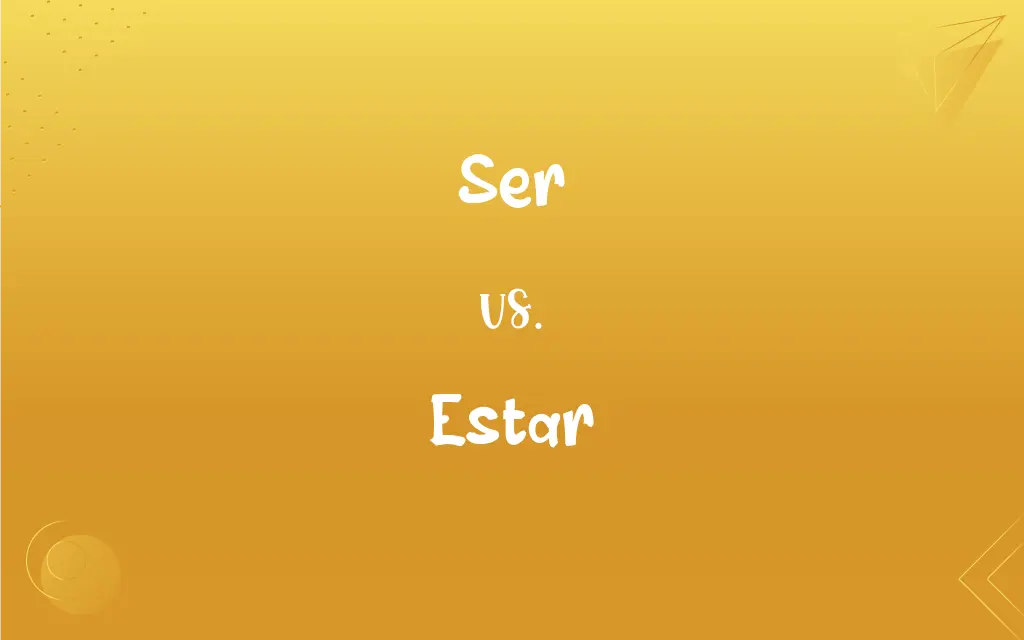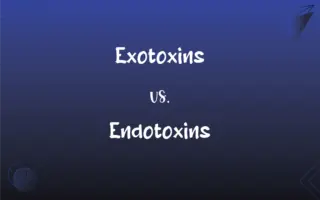Ser vs. Estar: What's the Difference?
Edited by Janet White || By Harlon Moss || Updated on October 20, 2023
In Spanish, "ser" pertains to inherent, permanent characteristics or identity, while "estar" relates to temporary states, conditions, or locations.

Key Differences
In the Spanish language, both "ser" and "estar" translate to "to be" in English. However, their usages differ based on context. "Ser" is used to describe inherent qualities, origin, or identity. In contrast, "estar" addresses temporary states, feelings, or positions in space.
The verb "ser" often aligns with permanent or long-lasting attributes. For example, it's employed when talking about one's nationality, profession, or inherent traits. If one says, "Soy profesor," it means "I am a teacher," indicating a chosen profession or identity. On the other side, "estar" signifies transient conditions. When someone remarks, "Estoy cansado," it translates to "I am tired," showcasing a fleeting feeling or state.
Locations also distinguish "ser" and "estar." While "ser" describes events or inherent locations, such as "La boda es en la iglesia" (The wedding is at the church), "estar" denotes specific or current spatial positions, as in "El libro está en la mesa" (The book is on the table).
Time is another domain where "ser" and "estar" diverge. "Ser" is used for days and dates, like "Hoy es lunes" (Today is Monday). Meanwhile, "estar" isn't typically used for time, but rather conditions or states at a particular moment.
Despite these guidelines, there are exceptions and nuances that make "ser" and "estar" complex for many learners. Their proper application often requires understanding the deeper context and cultural nuances of the language.
ADVERTISEMENT
Comparison Chart
Nature
Permanent or inherent qualities
Temporary states or conditions
Examples
Nationality, profession, identity
Feelings, locations, ongoing actions
Time
Used for days and dates
Not typically used for time
Locations
Describes event locations or inherent locations
Indicates specific or current spatial positions
Exceptions
Few, mostly idiomatic expressions
Context-based nuances, especially with adjectives
ADVERTISEMENT
Ser and Estar Definitions
Ser
Used for professions or roles.
Él es doctor. (He is a doctor.)
Estar
Describes temporary states or feelings.
Estoy feliz. (I am happy.)
Ser
Indicates origin or identity.
Somos de México. (We are from Mexico.)
Estar
Denotes conditions that are not inherent.
El vaso está sucio. (The glass is dirty.)
Ser
Describes inherent or essential qualities.
Ella es inteligente. (She is intelligent.)
Estar
Used with gerunds to form the progressive tense.
Están comiendo. (They are eating.)
Ser
Denotes possession or material.
Es mi libro. (It's my book.)
Estar
Expresses a change from the norm.
La sopa está caliente. (The soup is hot.)
Ser
Expresses time, days, or dates.
Hoy es viernes. (Today is Friday.)
Estar
Indicates current location or position.
La llave está en la mesa. (The key is on the table.)
Ser
(in some fantasy and sci-fi novels) An address or courtesy title to any person, especially if their gender and/or form of address are unknown.
Would ser care to dine this evening?
FAQs
Can "ser" describe locations?
Yes, "ser" describes event locations or inherent locations, not current positions.
Is "ser" for permanent traits only?
Mostly, but remember there are exceptions and idiomatic expressions.
How do I say "They are doctors"?
Use "ser": "Ellos son doctores."
What do both "ser" and "estar" mean in English?
Both "ser" and "estar" translate to "to be" in English.
How do I express that a building is located somewhere?
Use "estar" for specific positions: "El edificio está al lado del banco" (The building is next to the bank).
When should I use "ser"?
Use "ser" for inherent qualities, origin, identity, professions, and time.
Can "estar" be used for inherent qualities?
Typically no, "estar" is for conditions or states.
How do I say "It's my book"?
Use "ser": "Es mi libro."
If I'm saying a person is boring vs. a person is bored, which verbs do I use?
"Ser" for inherent qualities: "Él es aburrido" (He is boring). "Estar" for states: "Él está aburrido" (He is bored).
When is "estar" more appropriate?
"Estar" is for temporary states, feelings, current locations, and conditions.
How do I convey days of the week?
Use "ser." For example, "Hoy es lunes" (Today is Monday).
When expressing the location of a city, which verb do I use?
Use "ser" because the location is permanent: "Madrid es en España."
Which verb expresses mood or feelings?
Use "estar" for feelings: "Estoy triste" (I am sad).
How do I express an ongoing action in Spanish?
Use "estar" with a gerund, like "está corriendo" (he/she is running).
Can both verbs be used with the same adjectives?
Yes, but meanings can change. For example, "ser bueno" (to be good) vs. "estar bueno" (to taste good/look attractive).
How do I indicate I'm at a place temporarily?
Use "estar." For instance, "Estoy en el café" means "I am at the cafe."
Is "estar" used for health conditions?
Often, yes. Like "Estoy enfermo" (I am sick).
How do I say "I am a teacher" in Spanish?
You'd say "Soy profesor" using "ser" to indicate profession.
If a soup is hot, which verb should I use?
Use "estar" to express a condition: "La sopa está caliente."
How would I say "The concert is at the stadium"?
Use "ser": "El concierto es en el estadio."
About Author
Written by
Harlon MossHarlon is a seasoned quality moderator and accomplished content writer for Difference Wiki. An alumnus of the prestigious University of California, he earned his degree in Computer Science. Leveraging his academic background, Harlon brings a meticulous and informed perspective to his work, ensuring content accuracy and excellence.
Edited by
Janet WhiteJanet White has been an esteemed writer and blogger for Difference Wiki. Holding a Master's degree in Science and Medical Journalism from the prestigious Boston University, she has consistently demonstrated her expertise and passion for her field. When she's not immersed in her work, Janet relishes her time exercising, delving into a good book, and cherishing moments with friends and family.































































